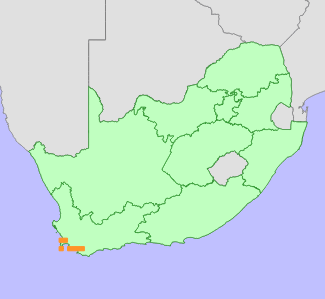|
Scientific Name | Erica capillaris Bartl. var. capillaris |
Higher Classification | Dicotyledons |
Family | ERICACEAE |
National Status |
Status and Criteria | Endangered B1ab(i,ii,iii,iv,v)+2ab(i,ii,iii,iv,v) |
Assessment Date | 2012/08/21 |
Assessor(s) | R.C. Turner & L. von Staden |
Justification | EOO 338 km², this formerly much more widespread taxon (historical EOO 2208 km²) now survives in only between three and five severely fragmented subpopulations, and continue to decline due to ongoing habitat loss, fragmentation and degradation due to expanding housing developments, agricultural expansion, competition from alien invasive plants and fire exclusion. |
Distribution |
Endemism | South African endemic |
Provincial distribution | Western Cape |
Range | Cape Peninsula to Stanford. |
Habitat and Ecology |
Major system | Terrestrial |
Major habitats | Peninsula Sandstone Fynbos, Overberg Sandstone Fynbos, Hangklip Sand Fynbos, Cape Flats Sand Fynbos |
Description | Sandy coastal flats and lower sandstone slopes. |
Threats |
| Urban expansion on the Cape Flats as well as the Cape coast between Betty's Bay and Hermanus has caused the loss of many subpopulations known from historical records. The last remaining subpopulation on the Cape Peninsula is protected, however, elsewhere, this species continues to decline due to ongoing habitat loss, fragmentation, expanding crop cultivation, competition from alien invasive plants and fire exclusion from small fragments. Particularly in areas such as Betty's Bay, where intact coastal plain habitat still remains, the future survival of this fire-dependent reseeder is unlikely as fires are excluded due to the risk to private property. |
Population |
Erica capillaris is known largely from historical records from areas now extensively transformed, with very few recent collections. It is extinct on the Cape Flats, but still survives on the Cape Peninsula, where a large subpopulation of more than 4000 mature individuals is protected within the Table Mountain National Park. Elsewhere, plants survive on small, isolated fragments amidst expanding coastal housing developments.
|
Population trend | Decreasing |
Assessment History |
Taxon assessed |
Status and Criteria |
Citation/Red List version | | Erica capillaris Bartl. var. capillaris | CR B1ab(i,ii,iii,iv,v) | 2012.1 | | Erica capillaris Bartl. var. capillaris | CR B1ab(i,ii,iii,iv,v) | Raimondo et al. (2009) | |
Bibliography |
Bolus, H., Guthrie, F. and Brown, N.E. 1909. Ericaceae. In: W.T. Thiselton-Dyer (ed). Flora Capensis IV Section I (Vacciniaceae to Gentianeae):2-418. Lovell Reeve & Co., Ltd., London.
Raimondo, D., von Staden, L., Foden, W., Victor, J.E., Helme, N.A., Turner, R.C., Kamundi, D.A. and Manyama, P.A. 2009. Red List of South African Plants. Strelitzia 25. South African National Biodiversity Institute, Pretoria.
Schumann, D., Kirsten, G. and Oliver, E.G.H. 1992. Ericas of South Africa. Fernwood Press, Cape Town.
|
Citation |
| Turner, R.C. & von Staden, L. 2012. Erica capillaris Bartl. var. capillaris. National Assessment: Red List of South African Plants version 2024.1. Accessed on 2025/10/24 |
 Comment on this assessment
Comment on this assessment


